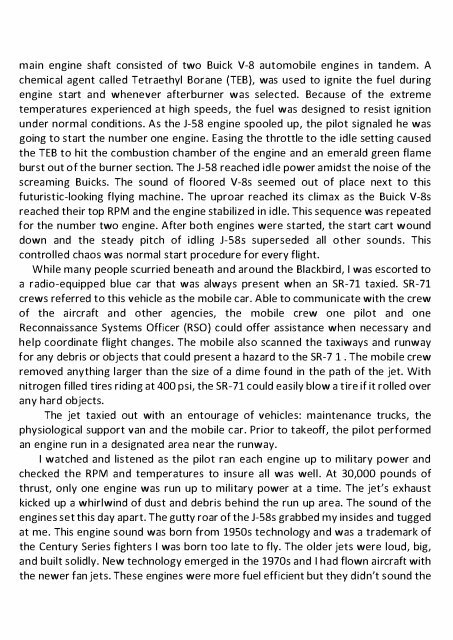You also want an ePaper? Increase the reach of your titles
YUMPU automatically turns print PDFs into web optimized ePapers that Google loves.
main engine shaft consisted of two Buick V-8 automobile engines in tandem. A<br />
chemical agent called Tetraethyl Borane (TEB), was used to ignite the fuel during<br />
engine start and whenever afterburner was selected. Because of the extreme<br />
temperatures experienced at high speeds, the fuel was designed to resist ignition<br />
under normal conditions. As the J-58 engine spooled up, the pilot signaled he was<br />
going to start the number one engine. Easing the throttle to the idle setting caused<br />
the TEB to hit the combustion chamber of the engine and an emerald green flame<br />
burst out of the burner section. The J-58 reached idle power amidst the noise of the<br />
screaming Buicks. The sound of floored V-8s seemed out of place next to this<br />
futuristic-looking flying machine. The uproar reached its climax as the Buick V-8s<br />
reached their top RPM and the engine stabilized in idle. This sequence was repeated<br />
for the number two engine. After both engines were started, the start cart wound<br />
down and the steady pitch of idling J-58s superseded all other sounds. This<br />
controlled chaos was normal start procedure for every flight.<br />
While many people scurried beneath and around the Blackbird, I was escorted to<br />
a radio-equipped blue car that was always present when an SR-71 taxied. SR-71<br />
crews referred to this vehicle as the mobile car. Able to communicate with the crew<br />
of the aircraft and other agencies, the mobile crew one pilot and one<br />
Reconnaissance Systems Officer (RSO) could offer assistance when necessary and<br />
help coordinate flight changes. The mobile also scanned the taxiways and runway<br />
for any debris or objects that could present a hazard to the SR-7 1 . The mobile crew<br />
removed anything larger than the size of a dime found in the path of the jet. With<br />
nitrogen filled tires riding at 400 psi, the SR-71 could easily blow a tire if it rolled over<br />
any hard objects.<br />
The jet taxied out with an entourage of vehicles: maintenance trucks, the<br />
physiological support van and the mobile car. Prior to takeoff, the pilot performed<br />
an engine run in a designated area near the runway.<br />
I watched and listened as the pilot ran each engine up to military power and<br />
checked the RPM and temperatures to insure all was well. At 30,000 pounds of<br />
thrust, only one engine was run up to military power at a time. The jet's exhaust<br />
kicked up a whirlwind of dust and debris behind the run up area. The sound of the<br />
engines set this day apart. The gutty roar of the J-58s grabbed my insides and tugged<br />
at me. This engine sound was born from 1950s technology and was a trademark of<br />
the Century Series fighters I was born too late to fly. The older jets were loud, big,<br />
and built solidly. New technology emerged in the 1970s and I had flown aircraft with<br />
the newer fan jets. These engines were more fuel efficient but they didn't sound the


